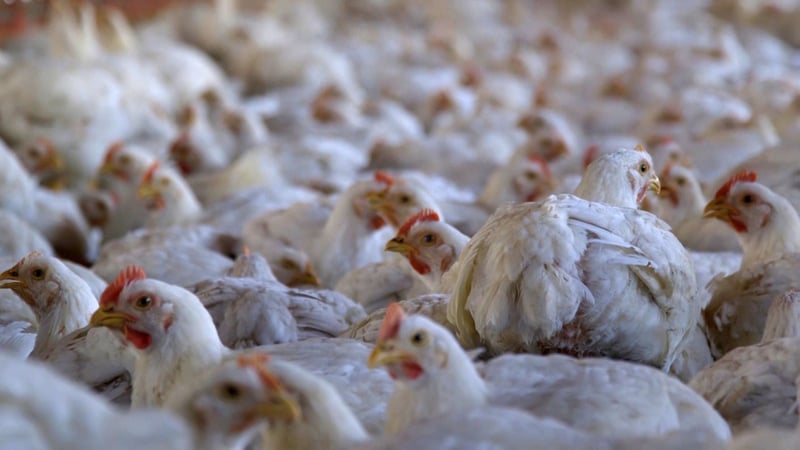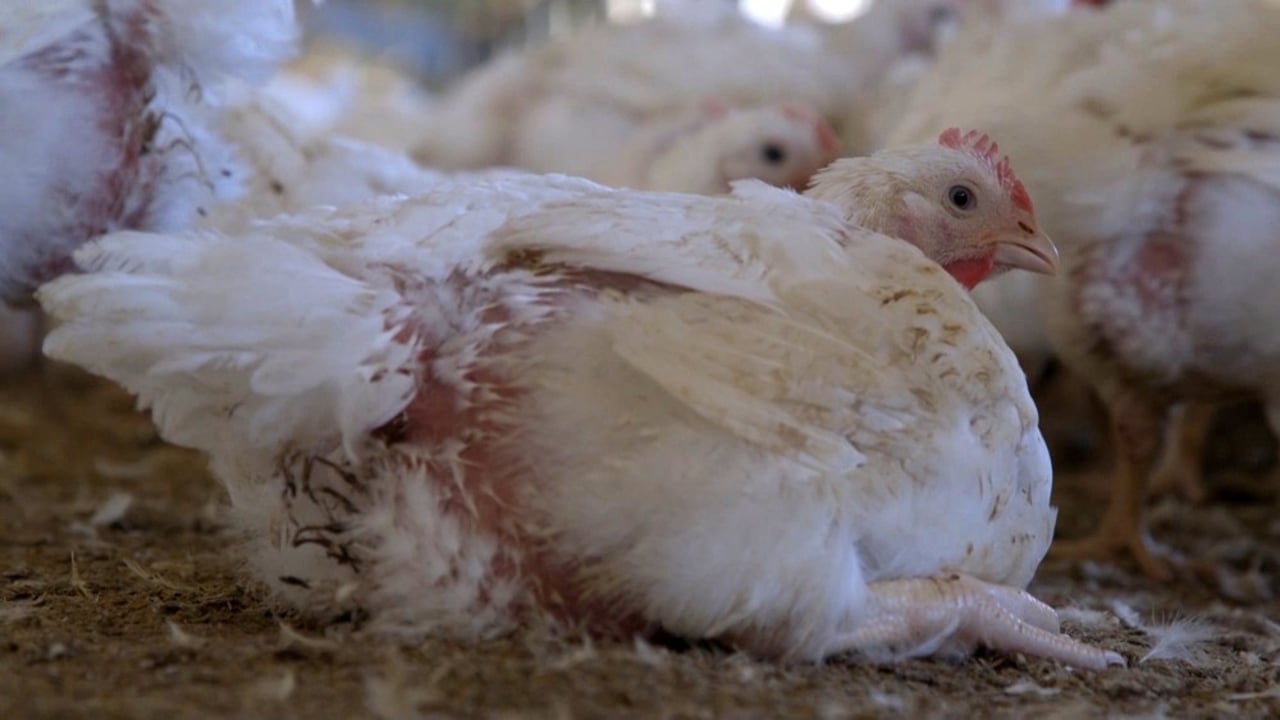
The brutal life of a meat chicken
News
Conditions on most chicken farms are sparse. There is abundant food and water and long hours of artificial light to encourage eating, but usually no natural light.
Top image: Approximately 28 day old broiler (meat) chickens in a commercial indoor system. This picture illustrates the conditions at one of many typical industrial indoor chicken farms, and does not reflect a supplier to any particular fast food outlet.
By Stephanie Brown, co-founder of the Canadian Coalition for Farm Animals. Originally published in The Hill Times
Life can be harsh for Canadian chickens destined to be meat today. Most birds live just 32 to 34 days–the result of extreme genetics, which force them to quickly reach slaughter weight. The birds are so young they chirp like chicks and are not fully feathered, but have a huge breast muscle. Such rapid growth is hard on birds, causing footpad lesions and lameness.
32 day old broiler (meat) chickens in a commercial indoor system.
In 2016, more than 706 million Canadian chickens were produced. Chickens, by far, are the most consumed animal in Canada. The least we must do is ensure conditions during their brief lives are the best possible, with minimal pain and suffering.
In Canada, most chicken eggs hatch in mechanized hatcheries, and chicks are immediately shipped to grow-out barns where they spend the next month eating and growing. A bird’s hatch date is determined by a pre-scheduled slaughter date.
On most chicken farms, conditions are sparse. There is abundant food and water and long hours of artificial light to encourage eating, but usually no natural light. Canadian standards allow lights to stay on 20 hours a day to encourage constant eating. With only four hours of darkness, there’s too little time to sleep.
On most farms, after about 30 days in the barn, birds are grabbed from the floor by “catchers” who are pressured to work quickly. Birds are carried upside down, seven or eight at a time, then pushed into crates for shipment to slaughter. Birds suffer injuries, including bruising and dislocated hips and wings.
Chickens are most commonly slaughtered using inhumane systems, where they are live-shackled upside down, dragged through electrically charged water for stunning, then toward spinning blades for neck-cutting. In these plants, 175 to 200 birds are processed per minute. The system is not failsafe. If birds raise their head, miss the stunner and neck cutters, and they can enter the scald tank still conscious. Better systems exist, but are rarely used in Canada.
Newer slaughter systems using gas don’t require upside-down live hanging. The best system, controlled-atmosphere killing, uses inert gas to kill birds. Another option, using carbon dioxide, is controlled atmosphere stunning (CAS). Several progressive Canadian chicken slaughter companies have, or are, converting to CAS. With CAS, birds are loaded on-farm into transport “drawers,” which are later moved directly to a CO2 tunnel for stunning without removal from drawers. This eliminates hanging and stunning in electrified water. Chicken Farmers of Ontario is requiring barns to accommodate these “drawers” for CAS slaughter by 2025.
Pity the breeder-parent birds
Breeder-parent birds produce the fertilized eggs that become Canada’s fast-growing meat chickens. Parent birds often suffer the same fast-growth genetics as their offspring. However, when these parent birds are old enough to reproduce, they are too heavy unless they are severely food and water restricted, including 48-hour food-withdrawal periods. Their progeny live 33 days, while parent birds live a year in extreme hunger.
Fast-growth genetics and outdated slaughter systems are key welfare issues. A North American coalition of animal-protection organizations, including the Canadian Coalition for Farm Animals, is asking food service suppliers and grocers to require slower-growth genetics, CAS slaughter, at least six hours of dark, and opportunities for birds to enjoy natural behaviours like dust-bathing, perching, and pecking, by 2024. Nearly 90 food-service suppliers and retailers, including Tim Hortons, Burger King, and Starbucks Canada, have accepted the challenge for improved treatment for chickens.
With these changes, future generations of meat chickens will have better living and dying conditions. For the consumer, the way to help animals is to cut back–or cut out meat consumption. The best thing you can do to help farm animals is not to eat them.
